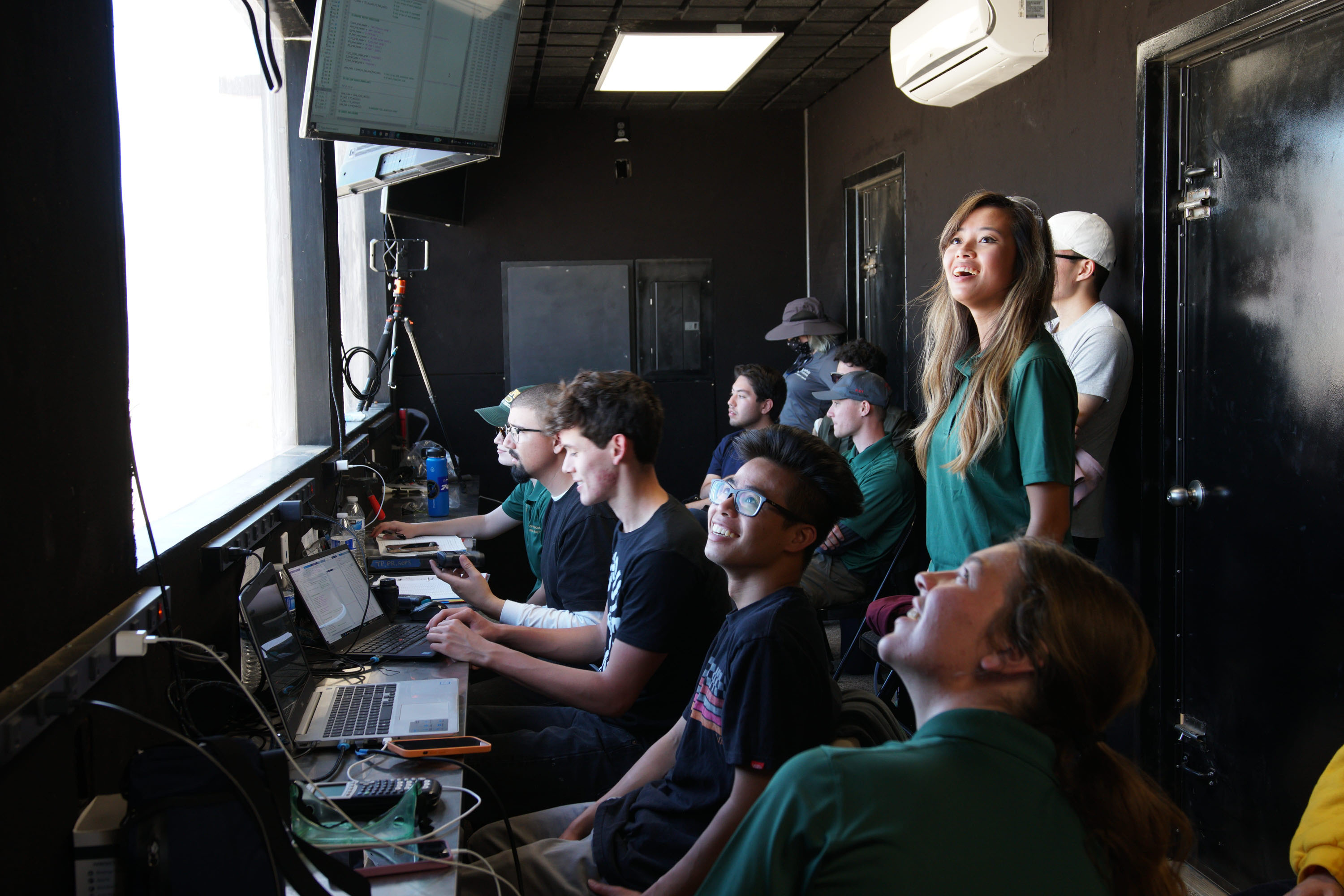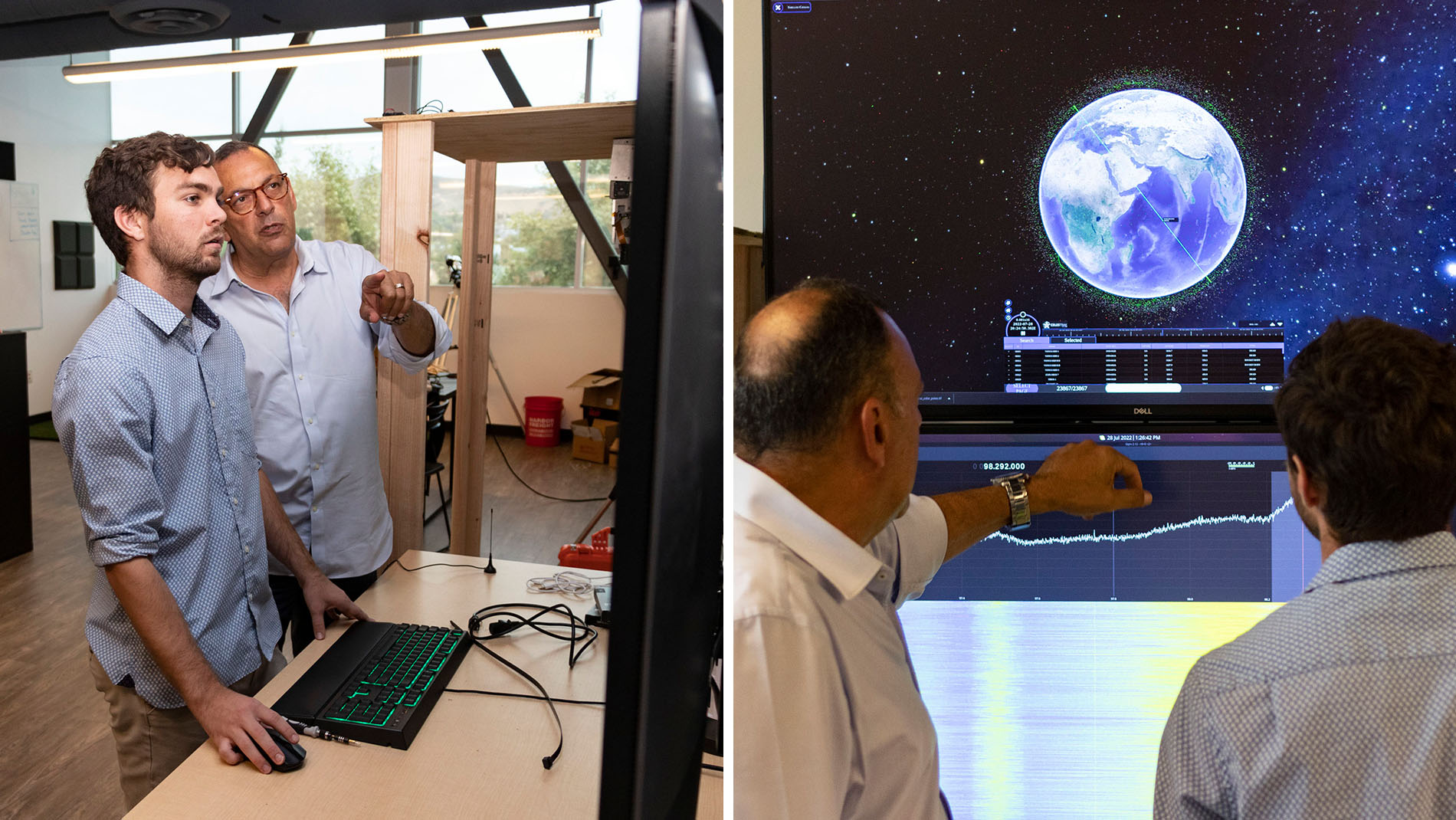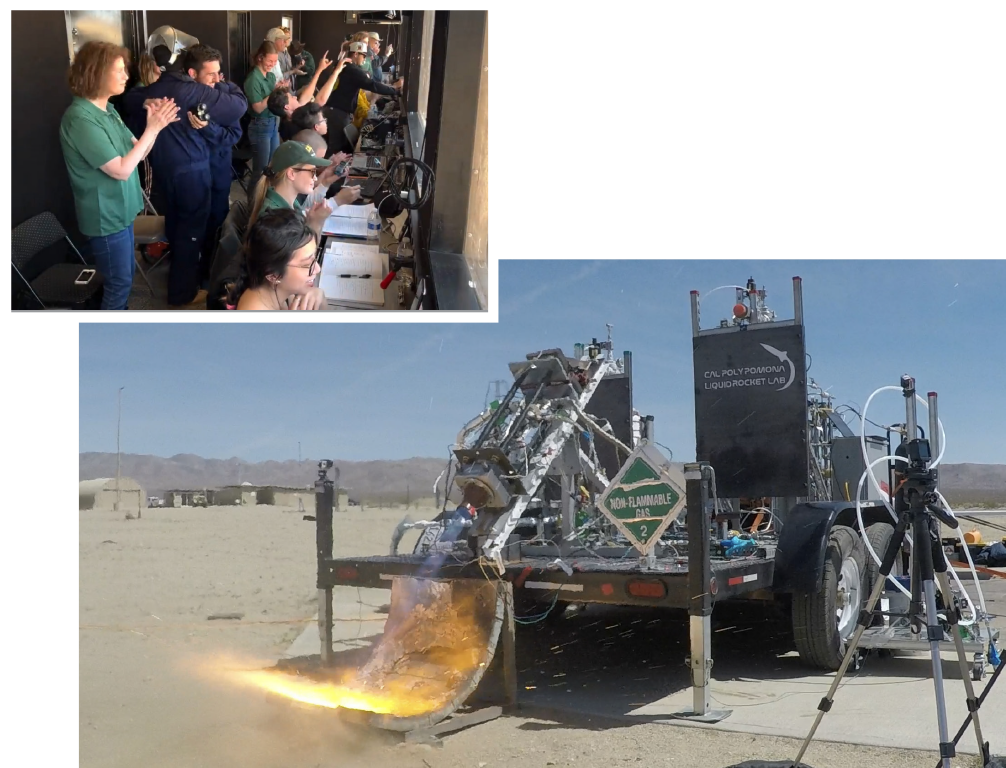Space Broncos
Nothing less than to the stars for these intrepid engineering students.
By Christopher Park and Cynthia Peters

History is Made
Bronco Space, a scrappy club of undergraduate students and their faculty advisor, has done it—their CubeSat, BroncoSat-1, is in space, which lifted off on May 25, 2022 from a SpaceX Falcon 9.
This marks the first space launch in Cal Poly Pomona’s history. And it took them just a year to build a launch-ready satellite.
“I’m over the moon excited,” says Zachary Gaines, aerospace engineering student and the project’s testing and integrations lead. “Especially after 1,000 hours of work it’s a big achievement.”
The project’s timeline sounds impossible. Typically, university teams take at least two years to launch anything into space. Further, space projects are often the domain of tier 1 research universities, which Cal Poly Pomona is not.
For Bronco Space, these precedents did not matter.
 The opportunity first came in June 2020 when space launch startup Momentus was looking to prove its capabilities with their scheduled Falcon 9 launch. A typical space launch costs $100,000 at minimum, so Bronco Space saw tremendous opportunity. Over a manic weekend they produced a viable design for their CubeSat—a miniature satellite about half the size of a loaf of bread.
The opportunity first came in June 2020 when space launch startup Momentus was looking to prove its capabilities with their scheduled Falcon 9 launch. A typical space launch costs $100,000 at minimum, so Bronco Space saw tremendous opportunity. Over a manic weekend they produced a viable design for their CubeSat—a miniature satellite about half the size of a loaf of bread.
“We hacked and slashed together a clean sheet design in a weekend. It was 54 hours of design work,” says Michael Pham, aerospace engineering student, founder of Bronco Space and BroncoSat-1’s team lead.
“At the beginning, we knew that if we were able to launch this, we would undisputedly be some of the greatest students who have ever gone to this university.” – Michael Pham, Aerospace Engineering Student and Founder of Bronco Space
The team aimed to prove that the hardware and software needed for artificial intelligence (AI) and machine-learning algorithms can be put into a satellite this small. In short, if the satellite in space sends back information derived from their algorithm, then it’s nominal mission success. Even that’s a step below core mission success, which is getting any kind of response from the satellite. Regardless of whether they hear back from BroncoSat-1, this is a major milestone, and it was never easy getting here.
Caption for above photo: Tarek Elsharhawy (left) and Michael Pham (right) at the launch pad for BroncoSat-1's launch. Elsharhawy is Bronco Space's faculty advisor and Pham is an aerospace engineering student and Bronco Space's founder.
Everything Went Wrong and That’s Okay
The team started with around a dozen members and doubled over time, calling forth the help of students across a wide set of disciplines—aerospace, mechanical, electrical, and computer engineering, and computer science. Throughout the project, the team only had one mode—full sprint—while solving one confounding problem after another.

The pace peaked in Jan. 2021, when too much went wrong at the same time.
“We had five boards, and all five died in a span of three days,” says Katherine Orozco, electrical engineering student and the club’s head analyst.
Printed circuit boards are an essential part of BroncoSat-1 as they transport power from one component to another. Imagine a highway with shipping trucks and replace the trucks with electrons.
One board had its power supply interrupted from a software error, killing it. Another board fried due to a flaw in its assembly. Each board went down in quick succession. There's a small box containing every dead board, and Orozco has thought of pithy eulogies for each one.
Setbacks like these were the norm, and the team overcame them time and time again. Orozco built new boards and the team soldiered (and soldered) forward.
This was just the half of it. Regulatory hurdles proved to be its own challenge, but Tarek Elsharhawy, faculty advisor for Bronco Space and a lecturer for the aerospace, electrical and computer, and mechanical engineering departments, was the man for the job.
Anything related to flight is heavily regulated. Anything related to space flight even more so. First, Cal Poly Pomona has its own procedures and rules for conducting flight projects. Outside of the university are two regulatory bodies, the Federal Aviation Administration (FAA) and NASA. From the former, you need to obtain a permit to be given clearance to fly. From the latter, you must meet a stringent set of design requirements for your design to be considered space-ready. Navigating these regulatory hurdles is a full-time job in and of itself.
Elsharhawy has advised Bronco Space and all its projects since 2020, connecting the club with industry, navigating bureaucracies, and guiding the students on technical and academic subjects. In addition, he guides the students' long-term vision for Bronco Space—elevate Cal Poly Pomona's status within the astronautics academic community.
Now, BroncoSat-1 orbits the Earth at roughly 17,000 miles per hour. Pham makes no reservations about the significance of the moment.
“At the beginning, we knew that if we were able to launch this, we would undisputedly be some of the greatest students who have ever gone to this university,” he says.
Whether or not you agree with this sentiment, what’s undeniable is that this assembly of student talent and faculty have done the improbable.
And this isn’t the end of it.
A (Launch) Date with NASA
After BroncoSat-1, it was a question of what’s next.
“Our success is finding a project that can be done in a one-year timeframe,” says Pham.
Taking what they learned and developed with their CubeSat, they worked on more earthly concerns. Derived from the AI and machine-learning work done for the BroncoSat-1 launch, the team developed a practical application for it. Bronco Ember, a CubeSat designed to detect nascent wildfires, passed its final inspection in the NASA TechLeap Prize and conducted a suborbital flight test with a Raven Aerostar high altitude balloon that took the satellite 18.5 miles above Earth for eight hours. Tracking the balloon, students lit fire pits to test the satellite’s ability to detect the fires and send them a message with the coordinates. NASA was impressed—the team earned $500,000 over the course of the competition.
Bronco Space was one of just three groups selected nationally to advance in the competition, which “focused on the advancement of integrated, compact precision pointing systems for small spacecraft that can be used to autonomously detect, locate, track, and collect data on transient terrestrial events.”
The students developed their CubeSat and its mission last summer under the orange skies of one of California’s worst wildfire seasons. Designed to be part of a network, Bronco Ember will scan for small wildfires, record the coordinates and send those coordinates to first responders giving them the opportunity to respond before the fires burn thousands of acres.
After advancing, the team had eight months to show NASA a proof of concept and just 10 months to finish their satellite. Bronco Ember weighs about three pounds and consists of a camera, a custom 2DOF (degrees-of-freedom) precision pointing system, and an edge computing system for onboard AI and advanced machine learning, all of which must fit into a compact container the size of a very slim shoebox.
“Early on, we focused on what we could build to show NASA some progress by the first review,” says Cristian Rodriguez (’22, master’s in mechanical engineering), the student principal investigator. “We wanted to show them how we would control the camera, get our data on altitude, and what a fire looks like in our optics. What we really needed to do was figure out was what was possible with our camera, and how we would determine what a fire even looks like from that distance.”
With supply chain issues in the initial phase, students began creating their own custom parts. Even with easing supply chains, about 40 percent of Bronco Ember’s parts are student-made.
A bigger hurdle was finding a dataset to train the Ember’s AI to recognize a fire. The team is imaging in shortwave infrared, which will give Bronco Ember the advantage of being able to see through smoke and clouds, but infrared images from space in that wavelength were not publicly available.
“What that forced us to do is to figure out ways to simulate images from space without going to space,” explained Gaines, the project manager for Ember. “We had a lot of skill testing, climbing mountains, going to beaches, making small fires, and scaling light sources—all to curate an environment similar to what we will see from altitude.”
In May, the team set up a campfire in the overflow parking lot and Gaines, who was on a hill 1.5 miles away, turned on the camera.
“There was this tiny little campfire glowing bright on my screen,” says Gaines. “It was so obvious where it was. I was looking at the same spot with my eyes, and I saw nothing, but my camera was just lighting up. That was the moment when I realized that what we’re doing is really possible, and what this imaging technology can do is really powerful.”
With their work on Ember, the students are gaining hands-on experience in a leading edge of space technology. The dramatically lower cost of CubeSats and their shorter development time compared to traditional satellites “is opening up space exploration like never before,” according to JPL. CubeSat technology is cited as a driver for miniaturization of systems and a new approach to packaging and integration as well as widening opportunities for space-based research beyond governments and the aerospace industry.
“Small satellite technology is really revolutionizing the industry,” says Gaines. “People are realizing they can get the same performance or better in smaller and dramatically less expensive satellites.”
In the case of Bronco Ember, there are fewer sensors and a smaller field of view than a traditional observation satellite, but a Bronco Ember network would be able to provide more consistent monitoring of an area for wildfire with its short-wave infrared imaging for a much lower total cost.
Gaines came to Cal Poly Pomona for its strong engineering program but didn’t expect the opportunities he’s had.
“It’s crazy to know that as a [student], I have a satellite orbiting overhead," reflects Gaines. “I’m a senior and getting support from NASA to do things I want to do. That’s the most enabling thing about Bronco Space. We really encourage people to do the things they love to do. We have a new lab space that anyone in the club can use, and Bronco Ember has brought in more funding for different projects allowing students to work on really cool space technology.”
Actually, This is Rocket Science
The Kármán line is 62 miles above the Earth's sea level.Considered the boundary between Earth’s atmosphere and outer space, that’s 327,360 feet or 1,091 football fields. It’s this illusive line that competing universities are trying to be the first to cross.
Being first is never easy, and these students aren’t settling for second.
Since 2017, a team of undergraduate students and faculty have operated under the banner of the Liquid Rocket Lab (LRL). Their aim for the last half-decade has gone unchanged—be the first university to launch a liquid rocket into space. Before that, a baby step—win the Friends of Amateur Rocketry’s Mars competition (FAR-Mars), which challenges teams to launch a liquid rocket 37,000 feet into the air in a timed and monitored test launch.
Several universities, like USC, UCLA, and SDSU are in the competition. To date, none have done it, illustrating just how hard this is.
This year, the team made significant headway with several successful tests on various aspects of their rocket, including the first successful static hot fire test of their liquid bipropellant engine, dubbed ACE. This a huge step as it confirms that the engine is working as expected.
“It hit more home for me since it was my third year on the team,” says Destry Lister, LRL’s overall project manager and aerospace engineering student. “Seeing all the work everyone has put into the engine from design to firing was a really amazing feeling.”
Essentially, their engine design works both in theory and practice. For their next step, the team will continue building the next iteration of ACE, the Z1 engine. This engine design aims to get their Bronco-2 rocket to space. It’ll be like ACE, except “completely on steroids.”

Up to now, the most successful liquid rocket launch has been conducted by UCLA during a FAR-Mars competition launch, where they reached 22,000 feet. LRL aims to soar past that by a significant amount with a goal of 37,000 feet with the proven ACE engine.
To achieve this, LRL’s earned $2.4 million worth of help from the Air Force Research Laboratory.
This federal funding is primarily put towards a 2,100 square-foot laboratory space dedicated to the sole purpose of building and launching liquid rockets. The lab houses a vast and necessary collection of hardware to shape and weld metal materials. Hand tools like saws and drills, a lathe mill, tube bender, and much more will give students hands-on experience to build their liquid rockets.
“The Liquid Rocket Lab program has had an immeasurable impact on student learning and my career at Cal Poly Pomona.” – Melody Neu, Former President of the Liquid Rocket Lab
An assembly room will enable students to assemble parts in-progress, leave them, and continue progress on another day. Prior to this enclosure, this basic convenience was impossible—teams borrowed the college’s structures lab to assemble parts, disassemble them, and then had to put them away to make room for classes taught in the lab. Tedious inefficiencies like these are now in the past.
“It is a great increase to our capability to perform well,” says Frank Chandler, Ph.D., director of LRL and aerospace engineering associate professor.
The journey continues. While the destination is important, what’s been done up to this point—both success and failures—have proved to be demonstrative in what it means to be an engineer. “The running joke is that LRL is like an industry simulator,” says Lister. “LRL alumni are doing what they did in the program but now in industry.”
“The Liquid Rocket Lab program has had an immeasurable impact on student learning and my career at Cal Poly Pomona,” says Melody Neu (’22, aerospace engineering), former LRL pres-ident and now a propulsion components test engineer at Virgin Orbit. “The hands-on experience I’ve gained through this project has directly prepared me in securing this dream career. I think the Liquid Rocket Lab project is the absolute embodiment of the learn by doing philosophy and I’m so grateful for my time here.”